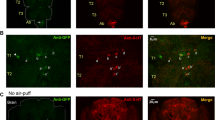Summary
-
1.
Male giant silkmoths generally show 3 distinct peaks of flight activity each day: a brief burst of flight after lights-off (α 1), a longer bout of activity later in the night (α 2), and a lights-on response. Theα 1 andα 2 activities are under circadian control, whereas the lights-on response occurs in response to an exogenous signal.
-
2.
Surgical experiments showed that the brain was necessary for the expression of the flight rhythm. Moreover, an intact neural pathway from the brain to the thoracic motor centers was needed for overt rhythmicity.
-
3.
Rhythmic flight activity continued after the removal of the optic lobes but not after excision of the cerebral lobes.
-
4.
Extirpation of the compound eyes did not interfere with the entrainment of theα 1 andα 2 peaks, but it abolished the lights-on response. Ablation of the ocelli had no effect on any of the flight peaks. It was concluded that the flight clock(s) was entrained by an extraretinal photoreceptor.
-
5.
Experiments involving covering the head with opaque wax indicated that the extraretinal receptor was in the head.
-
6.
When the head was covered with opaque wax but the compound eyes were left exposed, the moths showed free-running activity even though they were in a photoperiod regimen. Consequently, the only pathway of photoperiod information to the locomotor clock is apparently via the extraretinal receptor.
-
7.
It was concluded that adult activity was most likely controlled by centers in the cerebral lobe area of the brain. These presumably receive light directly and control activity via neural pathways to the thoracic ganglia.
Similar content being viewed by others
References
Aschoff, J.: Exogenous and endogenous components in circadian rhythms. Cold Spr. Harb. Symp. quant. Biol.25, 11–28 (1960)
Azaryan, A. G., Tyshchenko, V. P.: Role of cerebral neurons in regulation of the circadian rhythm of behavior of the cricketGryllus domesticus L. Dokl. Biol. Sci.186, 464–466 (1969)
Brady, J.: The physiology of insect circadian rhythms. Adv. Insect Physiol.10, 1–115 (1974)
Dickens, J. C., Eaton, J. L.: External ocelli in Lepidoptera previously considered to be anocellate. Nature (Lond.)242, 205–206 (1973)
Dumortier, B.: Photoreception in the circadian rhythm of stridulatory activity inEphippiger (Ins., Orthoptera). Likely existence of two photoreceptive systems. J. Comp. Physiol. 77, 80–112 (1972)
Hinks, C. F.: Relationship between serotonin and the circadian rhythm in some nocturnal moths. Nature (Lond.)214, 386–387 (1967)
Hoffmann, K.: Splitting of the circadian rhythm as a function of light intensity. In: Biochronometry (M. Menaker, ed.), p. 134–148. Washington: National Academy of Sciences Press 1971
Koyama, N.: Studies on the compound eye of the bombyeid moths. J. Shinshu Univ.4, 97–144 (1954)
Loher, W.: Circadian control of stridulation in the cricketTeleogryllus commodus Walker. J. comp. Physiol.79, 173–190 (1972)
Loher, W., Chandrashekaran, M. K.: Circadian rhythmicity in the oviposition of the grasshopperChorthippus curtipennis. J. Insect. Physiol.16, 1677–1688 (1970)
Nishiitsutsuji-Uwo, J., Pittendrigh, C. S.: Central nervous system control of circadian rhythmicity in the cockroach. II. The pathway of light signals that entrain the rhythm. Z. vergl. Physiol.58, 1–13 (1968a)
Nishiitsutsuji-Uwo, J., Pittendrigh, C. S.: Central nervous system control of circadian rhythmicity in the cockroach. III. The optic lobes, locus of the driving oscillation? Z. vergl. Physiol.58, 14–46 (1968b)
Nowosielski, J. W., Patton, R. L.: Studies on circadian rhythm of the house cricket,Gryllus domesticus L. J. Insect Physiol.9, 401–410 (1963)
Pittendrigh, C. S., Bruce, V. G., Kaus, P.: On the significance of transients in daily rhythms. Proc. nat. Acad. Sci. (Wash.)44, 965–973 (1958)
Roeder, K. D.: The control of tonus and looomotor activity in the praying mantis (Mantis religiosa L.). J. exp. Zool.76, 353–374 (1937)
Riddiford, L. M.: The role of hormones in the reproductive behavior of female wild silkmoths. In: Experimental analysis of insect behaviour (L. Barton Browne, ed.), p. 278–285. Berlin-Heidelberg-New York: Springer 1974
Riddiford, L. M., Johnson, L. K.: Synchronization of hatching ofAntheraea pernyi. Proc. XIIIth Internatl. Congr. Entomol., vol.1, 431 (1971)
Riddiford, L. M., Williams, C. M.: Role of the corpora cardiaca in the behavior of saturniid moths. I. Release of sex pheromone. Biol. Bull.140, 1–7 (1971)
Roberts, S. K., Skopik, S. D., Driskill, R. J.: Circadian rhythms in cockroaches: does brain hormone mediate the locomotor cycle ? In: Biochronometry (M. Menaker, ed.), p. 505–516. Washington: National Academy of Sciences Press 1971
Truman, J. W.: Hour-glass behavior of the circadian clock controlling eclosion of the silkmothAntheraea pernyi. Proc. nat. Acad. Sci. (Wash.)68, 595–599 (1971)
Truman, J. W.: Physiology if insect rhythms. I. Circadian organization of the endocrine events underlying the moulting cycle of larval tobacco hornworms. J. exp. Biol.57, 805–820 (1972a)
Truman, J. W.: Physiology of insect rhythms. II. The silkmoth brain as the location of the biological clock controlling eclosion. J. comp. Physiol.81, 99–114 (1972b)
Truman, J. W.: How moths “turn on”: a study of the action of hormones on the nervous system. Amer. Scientist61, 700–706 (1973a)
Truman, J. W.: Temperature sensitive programming of the silkmoth flight clock: a mechanism for adapting to the seasons. Science182, 727–729 (1973b)
Truman, J. W., Endo, P. T.: Physiology of insect ecdysis. Neural and hormonal factors involved in wing spreading behaviour of moths. J. exp. Biol., in press (1974)
Truman, J. W., Riddiford, L. M.: Neuroendocrine control of eedysis in silkmoths. Science167, 1624–1626 (1970)
Williams, C. M.: Physiology of insect diapause: the role of the brain in the production and termination of pupal dormancy in the giant silkmoth,Platysamia cecropia. Biol. Bull.90, 234–243 (1946)
Williams, C. M.: Physiology of insect diapause. IV. The brain and prothoracic glands as an endocrine system in theCecropia silkworm. Biol. Bull.103, 120–138 (1952)
Author information
Authors and Affiliations
Rights and permissions
About this article
Cite this article
Truman, J.W. Physiology of insect rhythms. J. Comp. Physiol. 95, 281–296 (1974). https://doi.org/10.1007/BF00609702
Received:
Issue Date:
DOI: https://doi.org/10.1007/BF00609702




